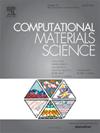Performance of exchange-correlation approximations to density functional theory for rare-earth oxides
IF 3.1
3区 材料科学
Q2 MATERIALS SCIENCE, MULTIDISCIPLINARY
引用次数: 0
Abstract
Rare-earth oxides (REOs) are an important class of materials owing to their unique properties, including high ionic conductivities, large dielectric constants, and elevated melting temperatures, making them relevant to several technological applications such as catalysis, ionic conduction, and sensing. The ability to predict these properties at moderate computational cost is essential to guiding materials discovery and optimizing materials performance. Although density functional theory (DFT) is the favored approach for predicting electronic and atomic structures, its accuracy is limited in describing strong electron correlation and localization inherent to REOs. The newly developed strongly constrained and appropriately normed (SCAN) meta-generalized-gradient approximations (meta-GGAs) promise improved accuracy in modeling these strongly correlated systems. We assess the performance of these meta-GGAs on binary REOs by comparing the numerical accuracy of thirteen exchange–correlation approximations in predicting structural, magnetic, and electronic properties. Hubbard U corrections for self-interaction errors and spin–orbit coupling are systematically considered. Our comprehensive assessment offers insights into the physical properties and functional performance of REOs predicted by first-principles and provides valuable guidance for selecting optimal DFT functionals for exploring these materials.

稀土氧化物密度泛函理论中交换相关近似的性能
稀土氧化物(REOs)是一类重要的材料,因为它们具有独特的性质,包括高离子传导性、大介电常数和较高的熔化温度,使其与催化、离子传导和传感等多种技术应用相关。以中等计算成本预测这些特性的能力对于指导材料发现和优化材料性能至关重要。虽然密度泛函理论(DFT)是预测电子和原子结构的首选方法,但它在描述 REOs 固有的强电子相关性和局域化方面的准确性有限。新开发的强约束和适当规范(SCAN)元广义梯度近似(meta-GGAs)有望提高这些强相关系统建模的准确性。我们通过比较 13 种交换相关近似方法在预测结构、磁性和电子特性方面的数值精度,评估了这些元广义梯度近似方法在二元 REO 上的性能。系统地考虑了自相互作用误差和自旋轨道耦合的 Hubbard U 修正。我们的全面评估深入揭示了第一原理预测的 REO 物理性质和功能性能,并为选择最佳 DFT 函数探索这些材料提供了宝贵的指导。
本文章由计算机程序翻译,如有差异,请以英文原文为准。
求助全文
约1分钟内获得全文
求助全文
来源期刊

Computational Materials Science
工程技术-材料科学:综合
CiteScore
6.50
自引率
6.10%
发文量
665
审稿时长
26 days
期刊介绍:
The goal of Computational Materials Science is to report on results that provide new or unique insights into, or significantly expand our understanding of, the properties of materials or phenomena associated with their design, synthesis, processing, characterization, and utilization. To be relevant to the journal, the results should be applied or applicable to specific material systems that are discussed within the submission.
 求助内容:
求助内容: 应助结果提醒方式:
应助结果提醒方式:


